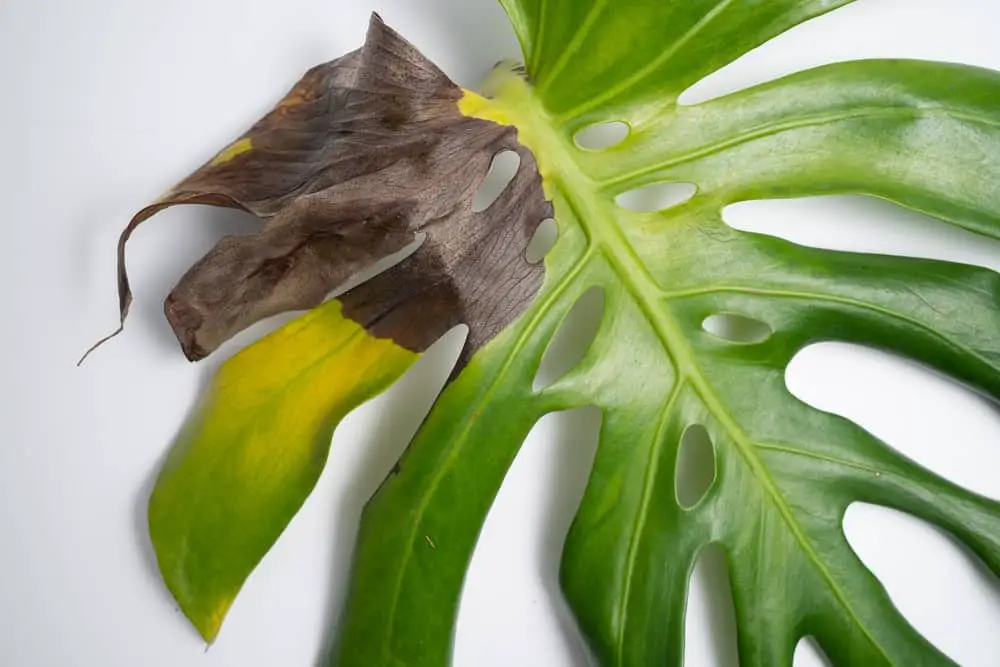Monstera plants are known by many names, most commonly the Swiss Cheese Plant. They are easy plants to care for, as they are well adapted to survive in all different sorts of conditions.
If you have a Monstera plant, you may have noticed that its leaves are turning yellow at least once. There are several reasons why this may be happening, and fortunately, there are also treatments available. So what are the most common causes of yellow Monstera leaves?
The most common reasons why your Monstera’s leaves turned yellow are due to too high moisture, different pests, or wrong type of climate. It can also be caused by wrong lightning or stress if you recently repotted it.
Keep reading to learn more about why your Monstera leaves may be turning yellow and what you can do about it!
Why Monstera Plants Gets Yellow Leaves
There are several conditions that can lead to yellowing leaves in the Monstera Plant.
1. Moisture
Improper watering is the top cause of yellowing leaves. If the soil is dry and the plant appears to be wilting, the likely culprit is underwatering of your plant. Underwatering will cause yellow or brown leaf edges on newer leaves first, then spread to cause yellowing of more mature foliage. If the soil is soggy and damp, overwatering is probably the problem. Overwatering typically causes yellow leaves across the whole plant, starting with the lower leaves first.
Humidity is also a factor with Monstera plants. As a tropical plant, Monstera plants do best in high levels of humidity. While these plants may tolerate low humidity for a while, exposing them to it for a long period can cause the leaves to yellow.
2. Pests
Weakened plants and those that have undergone stress are also more prone to infestation by pests. Monstera is often afflicted by many of the common indoor plant pests that attack all house plants, such as spider mites, mealybugs, and aphids.
To avoid these infestations, make sure you dust your plant weekly. This will help keep the leaves a beautiful shade of dark green.
3. Temperature and Climate
Monstera, like many houseplants, originated as tropical plants. Tropical plants grow best in temperatures between 65-80 °F When the temperature drops below this level, the plant’s growth may slow, and leaves may begin to turn yellow.
Monstera Plants do not do well with extreme weather changes or in very high or very low temperatures. If your plant is close to a door or window where there are frequent drafts or any other area with the temperature fluctuating wildly, you will need to move it.
4. Lighting
Monstera prefers bright, indirect light. If the plant is placed in direct sunlight, the sunlight may burn the plant. This will cause the leaves to turn yellow. If this happens, move the plant to a location that receives bright but indirect light.
Too little light can also cause yellowing leaves. When the Monstera plant does not receive enough light, it is unable to make sufficient chlorophyll. Chlorophyll is what gives its leaves a healthy dark green shade.
5. Transplant Stress
Yellow leaves could also be caused by transplant stress. This occurs when you repot the plant at the wrong time of year, use a different type of soil, or expose the roots.

The Monstera Plant
Monstera is a plant originally native to southern Mexico. They are a variety of breadfruit trees and their name roughly translates to Delicious Monster. Wild Monstera can grow extremely tall with beautiful wide leaves. They have become a popular houseplant because indoors they can be grown as large as you would like, if you have the space and provide them with an appropriately sized pot.
The leaf structure is often called the swiss cheese look, and it is more than just a beautiful design. The slashes in the leaves allow the plant to pass light down to the lower leaves. It also leaves them better equipped to withstand rain and wind. Water and wind pass through the leaves more easily enabling it to thrive.
When they are small, Monstera can grow on their own without any additional support. As they get bigger you will need to use something, such as a moss pole or a trellis, to help support them. They do best in low to medium light levels and should never be placed in direct sunlight.
They prefer soil that drains well and should only be watered when the topmost inches of soil are dry. These leafy philodendron plants are known to remove toxins from the air, so they are a great addition to your home.
Treatments
Moisture
- You should water your Monstera plant when the top inch of soil is dry. Normally once a week is appropriate, in most conditions.
- Make sure it is planted in a well-draining pot. This will prevent root rot. You can repot your plant in soil with better drainage if moisture is a consistent problem.
- Keep your watering consistent.
- If you catch the symptoms of overwatering soon enough, do not water your plant for a while until the soil has dried out.
- If your plant still has yellow leaves, even after appropriate watering, it might be root bound. Transfer the plant to a bigger pot where it will have more room to grow.
- Weekly misting of your plant can help keep the air around it moist if you live in an overly dry area.
- If you live in an extremely dry area, you may want to place a small pan of water by the base of the plant or invest in a humidifier.
Pests
- To avoid these infestations, make sure you give your plant a weekly dusting.
- For thrips, prune the affected leaves. For a larger scale thrip problem, purchase some neem oil or other natural insecticide. By spraying every few days, you can keep your plant free of thrips.
- Remove mealy bugs from the plant and then brush the plants with alcohol using a cotton ball.
- To get rid of spider mites water to squirt water on the bugs, or run lukewarm water, or hose water if it is warm, over the plant.
Cold damage
- Bring outdoor plants indoors when the temperature gets too low or when wide temperature swings are expected.
- Keep the plant between 60- and 80-degrees F during the day in the house and no lower than 55 degrees F at night.
Transplant Stress
- Return the plant to the same location you removed it from so that it has the same lighting and temperature as it did before you transplanted it.
- Prune off any leaves that are already dead or appear to be dying.
Lighting Issues
- Plants should not ever be kept in windows with direct sunlight.
- Hang a curtain over the window to diffuse the light coming through.
- Ensure your plant is close enough to a window that it is receiving indirect light.
How to Take Care of the Yellow Leaves
Once you have discovered and resolved the cause of the yellow leaves, they should return to their normal green color within a few months.
Sometimes, Monstera has yellow leaves as a natural part of their growth cycle. As the plant grows and matures, the leaves at the bottom of the plant may turn yellow. These leaves will eventually fall off and this is completely normal.
Conclusion
The Monstera is a beautiful versatile plant that is relatively easy to care for. Ensure you give your plant the proper amount of water and sunlight. Check your plant for pests and remove them if they are found. Repot plant as needed for growth but bear in mind that the Monstera will continue growing to accommodate any size pot. If you follow these steps you should not have any issues with the leaves turning yellow.
Keep reading: Yellow ZZ Plant Leaves
Victoria is the owner and main author of hobby plants. She loves spending her free time in her garden planting and taking care of her plants. Victoria hopes you enjoy the content here!

![Why Are My Orchid Leaves Turning Yellow? [Find Out Here] Why Are My Orchid Leaves Turning Yellow? [Find Out Here]](https://www.hobbyplants.com/wp-content/uploads/2022/07/orchid-leaves-turning-yellow-300x158.jpg)

![Why Is My Bamboo Plant Turning Yellow? [Find Out Here] Why Is My Bamboo Plant Turning Yellow? [Find Out Here]](https://www.hobbyplants.com/wp-content/uploads/2022/07/why-is-my-bamboo-turning-yellow-300x158.jpg)
![Why Is My Fiddle Leaf Fig Dropping Leaves? [ANSWERED] Why Is My Fiddle Leaf Fig Dropping Leaves? [ANSWERED]](https://www.hobbyplants.com/wp-content/uploads/2022/06/why-is-my-fiddle-leaf-fig-dropping-leaves-300x158.jpg)
![Why Are My Bird of Paradise Leaves Curling? [FIND OUT HERE] Why Are My Bird of Paradise Leaves Curling? [FIND OUT HERE]](https://www.hobbyplants.com/wp-content/uploads/2022/07/bird-of-paradise-leaves-curling-300x158.jpg)
![Why Are My Peace Lily Leaves Turning Brown? [EXPLAINED] Why Are My Peace Lily Leaves Turning Brown? [EXPLAINED]](https://www.hobbyplants.com/wp-content/uploads/2022/07/peace-lily-leaves-turning-brown-1-300x158.jpg)
